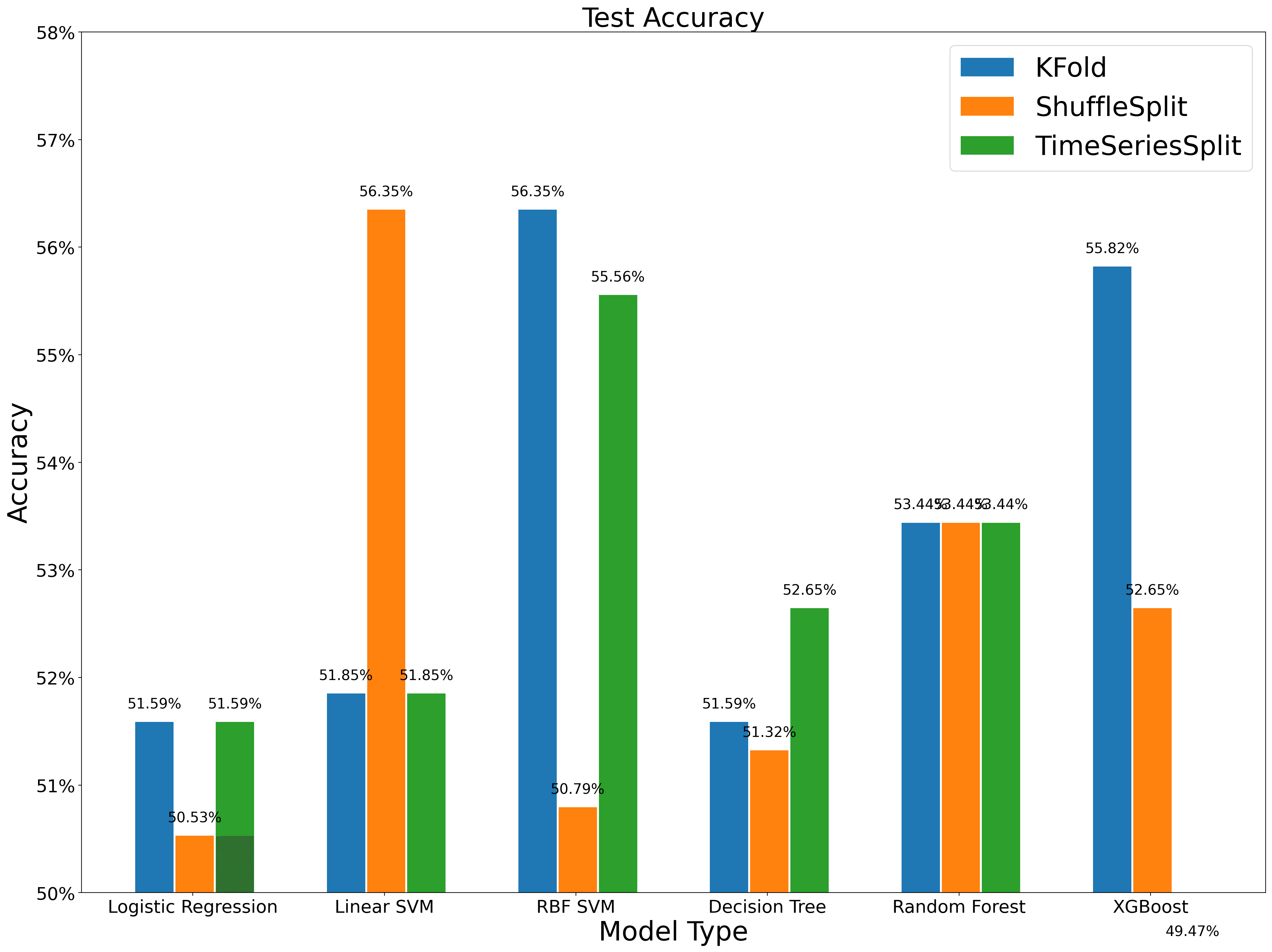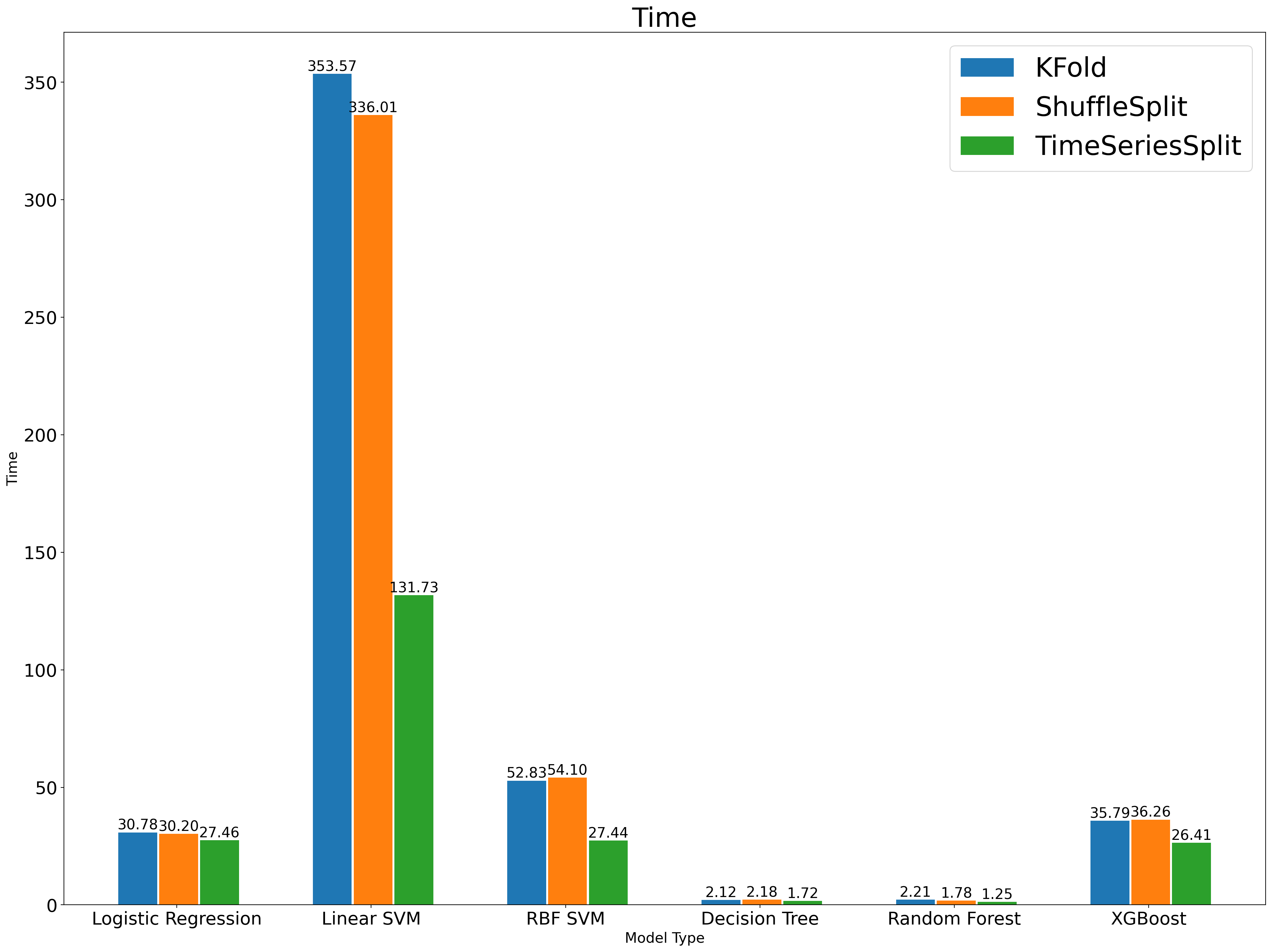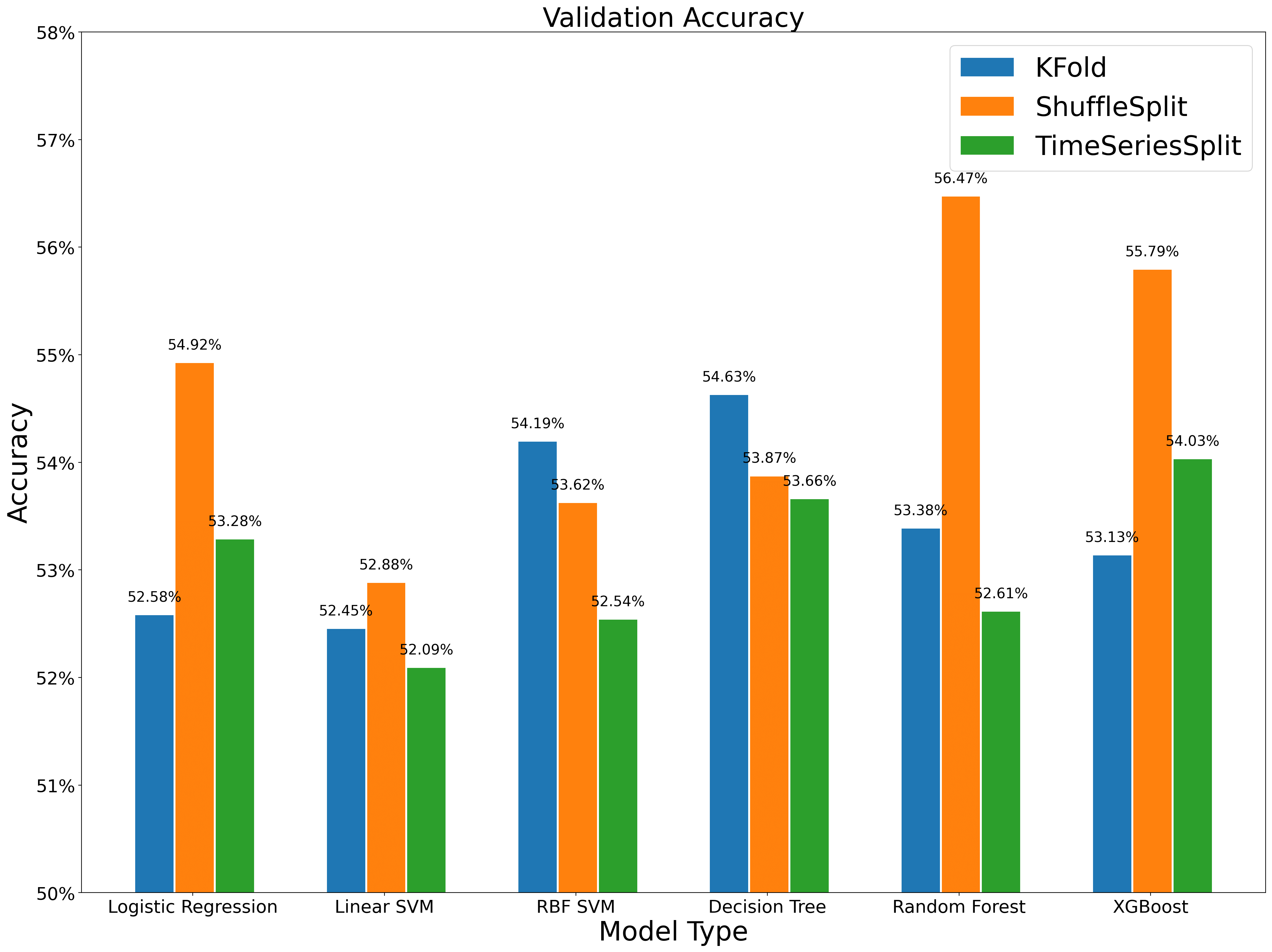K 折、随机和时间序列交叉验证的 Python 实现¶
相比 K 折、随机交叉验证方法,时序交叉验证方法不会用到未来信息预测历史结果,在测试集上的表现更稳健。时序交叉验证在时序数据上可以缓解过拟合问题,且训练耗时更少。

本文使用论坛文本数据(每日 25 条新闻标题)对道琼斯工业指数的涨跌方向进行分类预测。(数据来源:Kaggle Dataset)在信噪比极低的金融数据中,我们不期望预测效果有多么优秀。因此本文将重心放在多种交叉验证方法的实现与结果对比上。
我们发现 Shuffle 交叉验证在验证集上表现虽然优秀,但用到了很多未来信息预测历史结果,这是一种“作弊”行为,在现实中也是无法做到的。
在样本不满足独立同分布假设的时间序列数据上(如金融数据、医疗监测数据、销量数据等),更推荐使用时序交叉验证缓解过拟合问题,且训练时间开销更少。
特征工程代码片段¶
词频统计¶
# 词频统计
cnt_vectorizer = CountVectorizer(min_df=0.05)
cnt_train = cnt_vectorizer.fit_transform(train_headlines)
cnt_test = cnt_vectorizer.transform(test_headlines)
print(cnt_train.shape)
ev(cnt_train, cnt_test, cnt_vectorizer.get_feature_names())
TF-IDF¶
# TF-IDF
tfidf_vectorizer = TfidfVectorizer(stop_words="english")
tfidf_train = tfidf_vectorizer.fit_transform(train_headlines)
tfidf_test = tfidf_vectorizer.transform(test_headlines)
print(tfidf_train.shape)
ev(tfidf_train, tfidf_test, tfidf_vectorizer.get_feature_names())
2-gram TF-IDF¶
# TF-IDF: 2-gram
gram_vectorizer = TfidfVectorizer(min_df=0.03, ngram_range=(2, 2))
gram_train = gram_vectorizer.fit_transform(train_headlines)
gram_test = gram_vectorizer.transform(test_headlines)
gram_train.shape
ev(gram_train, gram_test, gram_vectorizer.get_feature_names())
交叉验证——以 XGBoost 为例¶
K 折和 Shuffle 交叉验证在验证集上的表现比在测试集上的表现优秀很多。我们认为可能是因为它们在训练集中泄露了未来信息。举例来说,如果我们在今天观察到输入信息是“Market Expansion”,并且股价是上涨的,此时如果我们要回头预测上个月的标签,发现上个月的输入信息也是“Market Expansion”,我们很可能会完美地预测股价上涨,并且预测正确。但是,在真实的环境下,我们在预测 11 月份标签的时候,只能看到 11 月 25 日及之前的情况,这时我们不知道“Market Expansion”对应的是什么标签,因此很可能预测不准确。
为了避免未来信息泄露,我们需要保证训练集在验证集之前。同时,交叉验证的思想是尽量多利用数据,所以我们采用时序交叉验证的办法。许多文献也表明,时序交叉验证在应对时序数据集上优于传统的交叉验证方法。
from sklearn.model_selection import KFold, ShuffleSplit, TimeSeriesSplit
import xgboost as xgb
from sklearn.model_selection import GridSearchCV, RandomizedSearchCV
import numpy as np
from tqdm import tqdm
import matplotlib.pyplot as plt
from matplotlib.patches import Patch
from matplotlib.ticker import PercentFormatter
交叉验证的数据¶
# 定义交叉验证所需的训练集、验证集和测试集
X_train_and_validation_for_cv = gram_train.toarray()
y_train_and_validation_for_cv = train["Label"].values
X_test_for_cv = gram_test.toarray()
y_test_for_cv = test["Label"].values
定义交叉验证划分方法的实例¶
# 定义 n_splits
n_splits = 5
# 定义交叉验证的实例
split_kfold = KFold(n_splits=n_splits)
split_shuffle = ShuffleSplit(n_splits=n_splits, test_size=1 / n_splits, random_state=0)
split_ts = TimeSeriesSplit(n_splits=n_splits)
定义函数,绘制不同交叉验证方法下,训练集和验证集的分布情况¶
def plot_cv_indices(split_method, X, ax, n_splits, lw=10):
"""
绘制交叉验证的训练集和验证集的分布情况
"""
# 生成交叉验证中训练集和验证集的索引
for ii, (tr, tt) in enumerate(split_method.split(X=X)):
# 填充训练集和验证集的索引
indices = np.array([np.nan] * len(X))
indices[tt] = 1
indices[tr] = 0
# 绘制每一个交叉验证的训练集和验证集的分布情况
ax.scatter(
range(len(indices)),
[ii + 0.5] * len(indices),
c=indices,
marker="_",
lw=lw,
cmap=plt.cm.coolwarm,
vmin=-0.2,
vmax=1.2,
)
yticklabels = list(range(1, n_splits + 1))
ax.set(
yticks=np.arange(n_splits) + 0.5,
yticklabels=yticklabels,
xlabel="Index",
ylabel="CV iteration",
ylim=[n_splits, -0.2],
xlim=[0, X_train_and_validation_for_cv.shape[0]],
)
ax.set_title("{}".format(type(split_method).__name__), fontsize=15)
return ax
绘制不同交叉验证方法下,训练集和验证集的分布情况¶
这幅图展示了三种交叉验证方法的划分结果。蓝色是训练集,红色是验证集。可以看到,K 折和 Shuffle 交叉验证都使用了未来信息来预测历史结果,而时序交叉验证很好地保证了训练集和验证集的先后顺序。
fig = plt.figure(figsize=(12, 4), dpi=200)
for i, split_method in enumerate([split_kfold, split_shuffle, split_ts]):
ax = fig.add_subplot(1, 3, 1 + i)
plot_cv_indices(split_method, X_train_and_validation_for_cv, ax, n_splits)
# 绘制图例
ax.legend(
[Patch(color=plt.cm.coolwarm(0.8)), Patch(color=plt.cm.coolwarm(0.02))],
["Validation set", "Training set"],
loc=(1.02, 0.85),
)
plt.tight_layout()
plt.show()

定义函数,汇总不同交叉验证方法下的最优参数¶
def get_best_params(cv_results):
# 将各个交叉验证方法寻找到的最佳参数进行汇总
best_params = pd.DataFrame.from_dict(
{method: cv_results[method]["Best_Params"] for method in cv_results.keys()},
orient="index",
)
# 删去 eval_metric 参数
best_params.drop("eval_metric", axis=1, inplace=True)
return best_params
定义函数,绘制不同交叉验证方法下的平均验证集准确率和测试集准确率¶
def plot_mean_validation_accuracy_and_test_accuracy(cv_results):
# 绘制不同交叉验证方法下的平均验证集准确率
fig = plt.figure(figsize=(6, 4), dpi=200)
ax = fig.add_subplot(1, 1, 1)
ax.bar(
x=np.arange(len(cv_results)),
height=[
cv_results[method]["Mean_Validation_Accuracy"] for method in cv_results
],
tick_label=[method for method in cv_results],
color="steelblue",
alpha=0.8,
width=0.4,
label="Mean Validation Accuracy",
)
# 在柱状图上方添加数字标签
for x, y in enumerate(
[cv_results[method]["Mean_Validation_Accuracy"] for method in cv_results]
):
plt.text(x, y + 0.001, "{:.2%}".format(y), ha="center", va="bottom")
# 绘制不同交叉验证方法下的测试集准确率
ax.bar(
x=np.arange(0.4, len(cv_results)),
height=[cv_results[method]["Test_Accuracy"] for method in cv_results],
tick_label=[method for method in cv_results],
color="indianred",
alpha=0.8,
width=0.4,
label="Test Accuracy",
)
# 在柱状图上方添加数字标签
for x, y in enumerate(
[cv_results[method]["Test_Accuracy"] for method in cv_results]
):
plt.text(x + 0.4, y + 0.001, "{:.2%}".format(y), ha="center", va="bottom")
# x 轴的刻度
ax.set_xticks(np.arange(0.2, len(cv_results)))
ax.set_xticklabels([method for method in cv_results])
ax.set_ylim([0.5, 0.58])
# ylabel 以百分数的形式显示
ax.yaxis.set_major_formatter(PercentFormatter(1.0, decimals=0))
ax.set_ylabel("Accuracy")
ax.legend(fontsize=8)
plt.show()
时序交叉验证的实现方法¶
第一种方法是向 cross_validation 方法中对folds参数直接传入一个Split实例。第二种方法是传入一个元组,这个元组包含了自定义的训练集索引和验证集索引,可以高度地定制任意训练集和验证集地划分方法。
详细的代码可以参考 这篇帖子。
网格搜索¶
网格搜索面临维数灾难,耗时较长,因此只尝试少量参数组合。
# 定义字典,用于存储不同交叉验证方法的结果
cv_results_grid = {}
# 定义网格搜索的参数
param_grid = {
"eta": [0.001, 0.01],
"gamma": [1, 0.1],
"max_depth": [2, 3],
"min_child_weight": [2, 3],
"eval_metric": ["logloss"],
}
for split_method in tqdm([split_kfold, split_shuffle, split_ts]):
cv_results_grid[type(split_method).__name__] = {
"Best_Params": None,
"Mean_Validation_Accuracy": None,
"Test_Accuracy": None,
}
# 定义网格搜索的实例
grid_search = GridSearchCV(
estimator=xgb.XGBClassifier(tree_method="gpu_hist"),
param_grid=param_grid,
cv=split_method,
scoring="accuracy",
n_jobs=-1,
verbose=1,
)
# 进行网格搜索
grid_search.fit(X_train_and_validation_for_cv, y_train_and_validation_for_cv)
# 记录最佳参数
cv_results_grid[type(split_method).__name__][
"Best_Params"
] = grid_search.best_params_
# 记录最佳参数下的平均验证集准确率
cv_results_grid[type(split_method).__name__][
"Mean_Validation_Accuracy"
] = grid_search.best_score_
# 记录最佳参数下的测试集准确率
cv_results_grid[type(split_method).__name__]["Test_Accuracy"] = grid_search.score(
X_test_for_cv, y_test_for_cv
)
Fitting 5 folds for each of 16 candidates, totalling 80 fits
100%|██████████| 3/3 [01:00<00:00, 20.05s/it]
| eta | gamma | max_depth | min_child_weight | |
|---|---|---|---|---|
| KFold | 0.001 | 1.0 | 3 | 2 |
| ShuffleSplit | 0.001 | 1.0 | 2 | |
| TimeSeriesSplit | 0.010 | 0.1 | 2 |

随机搜索¶
# 定义字典,用于存储不同交叉验证方法的结果
cv_results_random = {}
# 定义随机搜索的参数
param_grid = {
"eta": [0.005, 0.01, 0.015],
"gamma": [1, 0.1, 0.01],
"max_depth": [2, 3, 4, 5],
"min_child_weight": [2, 3, 4, 5],
"eval_metric": ["logloss"],
}
for split_method in tqdm([split_kfold, split_shuffle, split_ts]):
cv_results_random[type(split_method).__name__] = {
"Best_Params": None,
"Mean_Validation_Accuracy": None,
"Test_Accuracy": None,
}
# 定义随机搜索的实例
rondom_search = RandomizedSearchCV(
estimator=xgb.XGBClassifier(tree_method="gpu_hist"),
param_distributions=param_grid,
n_iter=20,
cv=split_method,
scoring="accuracy",
n_jobs=-1,
verbose=1,
random_state=0,
)
# 进行随机搜索
rondom_search.fit(X_train_and_validation_for_cv, y_train_and_validation_for_cv)
# 记录最佳参数
cv_results_random[type(split_method).__name__][
"Best_Params"
] = rondom_search.best_params_
# 记录最佳参数下的平均验证集准确率
cv_results_random[type(split_method).__name__][
"Mean_Validation_Accuracy"
] = rondom_search.best_score_
# 记录最佳参数下的测试集准确率
cv_results_random[type(split_method).__name__][
"Test_Accuracy"
] = rondom_search.score(X_test_for_cv, y_test_for_cv)
Fitting 5 folds for each of 20 candidates, totalling 100 fits
100%|██████████| 3/3 [01:29<00:00, 29.67s/it]
从众多参数组合中随机选出 20 个,再从这 20 个参数组合中选出在验证集上平均预测准确率最高的。
| min_child_weight | max_depth | gamma | eta | |
|---|---|---|---|---|
| KFold | 5 | 4 | 1.0 | 0.010 |
| ShuffleSplit | 2 | 0.1 | 0.005 | |
| TimeSeriesSplit | 5 | 4 | 1.0 | 0.010 |

可以看到,ShuffleSplit 方法存在明显的过拟合问题,其在交叉验证时的验证集上表现非常好,但在测试集上表现最差。TimeSeriesSplit 方法虽然在交叉验证时表现较差,但在测试集上表现最好。
交叉验证——对比多种模型¶
在多个模型上进行训练,发现 Shuffle 方法在验证集上总是表现最好的那个,但在测试集上的表现并不稳定。尤其是复杂的高斯核 SVM 和 XGBoost 模型,我们推测是因为复杂的模型对超参数更加敏感。
def cv_grid_one(model):
# 定义字典,用于存储不同交叉验证方法的结果
cv_results_grid = {}
# 定义网格搜索的参数
param_grid = {
"eta": [0.001, 0.01],
"gamma": [1, 0.1],
"max_depth": [2, 3],
"min_child_weight": [2, 3],
"eval_metric": ["logloss"],
}
for split_method in tqdm([split_kfold, split_shuffle, split_ts]):
cv_results_grid[type(split_method).__name__] = {
"Best_Params": None,
"Mean_Validation_Accuracy": None,
"Test_Accuracy": None,
}
# 定义网格搜索的实例
grid_search = GridSearchCV(
estimator=model,
param_grid=param_grid,
cv=split_method,
scoring="accuracy",
n_jobs=-1,
verbose=1,
)
# 进行网格搜索
t1 = time.time()
grid_search.fit(X_train_and_validation_for_cv, y_train_and_validation_for_cv)
t2 = time.time()
# 记录最佳参数
cv_results_grid[type(split_method).__name__][
"Best_Params"
] = grid_search.best_params_
# 记录最佳参数下的平均验证集准确率
cv_results_grid[type(split_method).__name__][
"Mean_Validation_Accuracy"
] = grid_search.best_score_
# 记录最佳参数下的测试集准确率
cv_results_grid[type(split_method).__name__][
"Test_Accuracy"
] = grid_search.score(X_test_for_cv, y_test_for_cv)
cv_results_grid[type(split_method).__name__]["time"] = t2 - t1
cv_results_grid[type(split_method).__name__][
"best_estimator"
] = grid_search.best_estimator_
return cv_results_grid
from scipy.stats import randint
from scipy.stats import uniform
def cv_random_one(model):
# 定义字典,用于存储不同交叉验证方法的结果
cv_results_random = {}
# 定义随机搜索的参数
if model == xgb_model:
param_random = {
"eta": [0.005, 0.01, 0.015],
"gamma": [1, 0.1, 0.01],
"max_depth": [2, 3, 4, 5],
"min_child_weight": [2, 3, 4, 5],
"eval_metric": ["logloss"],
}
if model == linearsvm_model or model == gssvm_model:
param_random = {"C": [1, 10, 100, 1000], "gamma": [1, 0.1, 0.01, 0.001]}
if model == RF_model:
param_random = {
"n_estimators": randint(low=1, high=200),
"max_features": randint(low=7, high=9),
}
if model == tree_model:
param_random = {"max_depth": [1, 2, 3, 4, 5, 6, 7, None]}
if model == LR_model:
param_random = {"C": uniform(loc=0, scale=4), "penalty": ["l2", "l1"]}
for split_method in tqdm([split_kfold, split_shuffle, split_ts]):
cv_results_random[type(split_method).__name__] = {
"Best_Params": None,
"Mean_Validation_Accuracy": None,
"Test_Accuracy": None,
}
# 定义随机搜索的实例
rondom_search = RandomizedSearchCV(
estimator=model,
param_distributions=param_random,
n_iter=20,
cv=split_method,
scoring="accuracy",
n_jobs=-1,
verbose=1,
random_state=0,
)
# 进行随机搜索
t1 = time.time()
rondom_search.fit(X_train_and_validation_for_cv, y_train_and_validation_for_cv)
t2 = time.time()
# 记录最佳参数下的平均验证集准确率
cv_results_random[type(split_method).__name__][
"Mean_Validation_Accuracy"
] = rondom_search.best_score_
# 记录最佳参数下的测试集准确率
cv_results_random[type(split_method).__name__][
"Test_Accuracy"
] = rondom_search.score(X_test_for_cv, y_test_for_cv)
# 时间
cv_results_random[type(split_method).__name__]["time"] = t2 - t1
cv_results_random[type(split_method).__name__][
"best_estimator"
] = rondom_search.best_estimator_
return cv_results_random
import matplotlib
import matplotlib.pyplot as plt
import numpy as np
def autolabel(rects):
"""在* rects *中的每个柱状条上方附加一个文本标签,显示其高度"""
for rect in rects:
height = rect.get_height()
ax.annotate(
"{}".format(height),
xy=(rect.get_x() + rect.get_width() / 2, height),
xytext=(0, 3), # 3 点垂直偏移
textcoords="offset points",
ha="center",
va="bottom",
)
def plot_compare(a, b, c, title):
fig = plt.figure(figsize=(20, 15), dpi=200)
ax = fig.add_subplot(1, 1, 1)
# plt.rcParams['font.sans-serif']=['SimHei'] # 解决中文乱码
labels = [
"Logistic Regression",
"Linear SVM",
"RBF SVM",
"Decision Tree",
"Random Forest",
"XGBoost",
]
x = np.arange(len(labels)) # 标签位置
width = 0.2 # 柱状图的宽度,可以根据自己的需求和审美来改
rects1 = ax.bar(x - width, a, width, label="KFold")
rects2 = ax.bar(x + 0.01, b, width, label="ShuffleSplit")
rects3 = ax.bar(x + 0.02 + width, c, width, label="TimeSeriesSplit")
# 为 y 轴、标题和 x 轴等添加一些文本。
# 在柱状图上方添加数字标签
if title != "Time":
for m, y in enumerate(a):
plt.text(
m - width,
y + 0.001,
"{:.2%}".format(y),
ha="center",
va="bottom",
fontsize=16,
)
for m, y in enumerate(b):
plt.text(
m + 0.01,
y + 0.001,
"{:.2%}".format(y),
ha="center",
va="bottom",
fontsize=16,
)
for m, y in enumerate(c):
plt.text(
m + 0.02 + width,
y + 0.001,
"{:.2%}".format(y),
ha="center",
va="bottom",
fontsize=16,
)
ax.set_ylim([0.5, 0.58])
ax.yaxis.set_major_formatter(PercentFormatter(1.0, decimals=0))
ax.set_ylabel("Accuracy", fontsize=30)
ax.set_xlabel("Model Type", fontsize=30)
if title == "Time":
for m, y in enumerate(a):
plt.text(
m - width,
y + 0.001,
"{:.2f}".format(y),
ha="center",
va="bottom",
fontsize=16,
)
for m, y in enumerate(b):
plt.text(
m + 0.01,
y + 0.001,
"{:.2f}".format(y),
ha="center",
va="bottom",
fontsize=16,
)
for m, y in enumerate(c):
plt.text(
m + 0.02 + width,
y + 0.001,
"{:.2f}".format(y),
ha="center",
va="bottom",
fontsize=16,
)
ax.set_ylabel("Time", fontsize=16)
ax.set_xlabel("Model Type", fontsize=16)
ax.set_title(title, fontsize=30)
ax.set_xticks(x)
ax.set_xticklabels(labels, fontsize=20)
ax.tick_params(labelsize=20)
ax.legend(fontsize=30)
# ylabel 以百分数的形式显示
autolabel(rects1)
autolabel(rects2)
autolabel(rects3)
fig.tight_layout()
plt.show()
a_valid = list()
b_valid = list()
c_valid = list()
a_test = list()
b_test = list()
c_test = list()
a_time = list()
b_time = list()
c_time = list()
for model in [xgb_model, linearsvm_model, gssvm_model, tree_model, LR_model, RF_model]:
k = cv_random_one(model)
a_valid.append(k["KFold"]["Mean_Validation_Accuracy"])
b_valid.append(k["ShuffleSplit"]["Mean_Validation_Accuracy"])
c_valid.append(k["TimeSeriesSplit"]["Mean_Validation_Accuracy"])
a_test.append(k["KFold"]["Test_Accuracy"])
b_test.append(k["ShuffleSplit"]["Test_Accuracy"])
c_test.append(k["TimeSeriesSplit"]["Test_Accuracy"])
a_time.append(k["KFold"]["time"])
b_time.append(k["ShuffleSplit"]["time"])
c_time.append(k["TimeSeriesSplit"]["time"])
plot_compare(a_valid, b_valid, c_valid, "Validation Accuracy")
plot_compare(a_test, b_test, c_test, "Test Accuracy")
plot_compare(a_time, b_time, c_time, "Time")



最后我们比较了三种方法的训练时间,可以看到时序交叉验证的耗时基本是其他两种方法的一半,这本质上是因为它整体上只用到了一半的训练数据。这也给了我们一个启发:训练集的样本量也是影响拟合程度的因素,如果控制住它,结论会不会仍然成立呢?
控制训练集样本量¶
时序交叉验证带来的预测效果的提升,究竟是
- 保留了样本的时序信息;
- 还是因为时序交叉验证使用更少(接近一半)的样本量。
定义颜色 Colormap,将未被选为训练集的样本描述为白色。
将 K 折和 Shuffle 的训练集样本量减少到和时序交叉验证相同。图中的蓝色仍然是训练集,红色仍然是验证集,但有一部分的白色是被我们剔除的训练集,这样我们就能够控制三种方法的训练集样本量。
from matplotlib.colors import LinearSegmentedColormap
# Create a new colormap that goes from blue to white to red
my_colormap = LinearSegmentedColormap.from_list(
"my_colormap", [(0, "blue"), (0.5, "white"), (1, "red")]
)
def split_less_sample(split_method, X):
in_and_out_list = []
i = 1
for train_index, test_index in split_method.split(X=X):
train_index = list(train_index)
test_index = list(test_index)
# Randomly shuffle the list
random.shuffle(train_index)
# Delete some items from the list
if i != n_splits: # 若没到最后一轮,则需要减少传统交叉验证的训练集样本量
train_index = train_index[: i * (len(X)) // (n_splits + 1)]
i += 1
# Sort the list
train_index.sort()
in_and_out = (train_index, test_index)
in_and_out_list.append(in_and_out)
return in_and_out_list
def plot_cv_indices_less_sample(split_method, X, ax, n_splits, lw=10):
"""
绘制交叉验证的训练集和验证集的分布情况,并且训练集的样本量保证与时序交叉验证的训练集样本量相同
"""
in_and_out_list = split_less_sample(split_method, X)
# print(in_and_out_list)
# 生成交叉验证中训练集和验证集的索引
for ii, (tr, tt) in enumerate(in_and_out_list):
# 填充训练集和验证集的索引
indices = np.array([np.nan] * len(X))
indices[tt] = 1
indices[tr] = 0
indices[np.where(np.isnan(indices))] = 0.5
# print(indices)
# 绘制每一个交叉验证的训练集和验证集的分布情况
ax.scatter(
range(len(indices)),
[ii + 0.5] * len(indices),
c=indices,
marker="_",
lw=lw,
cmap=plt.cm.coolwarm,
vmin=-0.2,
vmax=1.2,
)
yticklabels = list(range(1, n_splits + 1))
ax.set(
yticks=np.arange(n_splits) + 0.5,
yticklabels=yticklabels,
xlabel="Index",
ylabel="CV iteration",
ylim=[n_splits, -0.2],
xlim=[0, X_train_and_validation_for_cv.shape[0]],
)
ax.set_title("{}".format(type(split_method).__name__), fontsize=15)
return ax
fig = plt.figure(figsize=(12, 4), dpi=200)
split_kfold = KFold(n_splits=n_splits)
split_shuffle = ShuffleSplit(n_splits=n_splits, test_size=1 / n_splits, random_state=0)
split_ts = TimeSeriesSplit(n_splits=n_splits)
for i, split_method in enumerate([split_kfold, split_shuffle, split_ts]):
ax = fig.add_subplot(1, 3, 1 + i)
plot_cv_indices_less_sample(
split_method, X_train_and_validation_for_cv, ax, n_splits
)
# 绘制图例
ax.legend(
[Patch(color=plt.cm.coolwarm(0.8)), Patch(color=plt.cm.coolwarm(0.02))],
["Validation set", "Training set"],
loc=(1.02, 0.85),
)
plt.tight_layout()
plt.show()

在相同训练集样本量的情况下,比较各模型的优劣¶
def cv_random_one_less_sample(model):
# 定义字典,用于存储不同交叉验证方法的结果
cv_results_random = {}
# 定义随机搜索的参数
if model == xgb_model:
param_random = {
"eta": [0.005, 0.01, 0.015],
"gamma": [1, 0.1, 0.01],
"max_depth": [2, 3, 4, 5],
"min_child_weight": [2, 3, 4, 5],
"eval_metric": ["logloss"],
}
if model == linearsvm_model or model == gssvm_model:
param_random = {"C": [1, 10, 100, 1000], "gamma": [1, 0.1, 0.01, 0.001]}
if model == RF_model:
param_random = {
"n_estimators": randint(low=1, high=200),
"max_features": randint(low=7, high=9),
}
if model == tree_model:
param_random = {"max_depth": [1, 2, 3, 4, 5, 6, 7, None]}
if model == LR_model:
param_random = {"C": uniform(loc=0, scale=4), "penalty": ["l2", "l1"]}
for split_method in tqdm([split_kfold, split_shuffle, split_ts]):
cv_results_random[type(split_method).__name__] = {
"Best_Params": None,
"Mean_Validation_Accuracy": None,
"Test_Accuracy": None,
}
# 定义随机搜索的实例
rondom_search = RandomizedSearchCV(
estimator=model,
param_distributions=param_random,
n_iter=20,
cv=split_less_sample(split_method, X_train_and_validation_for_cv),
scoring="accuracy",
n_jobs=-1,
verbose=1,
random_state=0,
)
# 进行随机搜索
t1 = time.time()
rondom_search.fit(X_train_and_validation_for_cv, y_train_and_validation_for_cv)
t2 = time.time()
# 记录最佳参数下的平均验证集准确率
cv_results_random[type(split_method).__name__][
"Mean_Validation_Accuracy"
] = rondom_search.best_score_
# 记录最佳参数下的测试集准确率
cv_results_random[type(split_method).__name__][
"Test_Accuracy"
] = rondom_search.score(X_test_for_cv, y_test_for_cv)
# 时间
cv_results_random[type(split_method).__name__]["time"] = t2 - t1
cv_results_random[type(split_method).__name__][
"best_estimator"
] = rondom_search.best_estimator_
return cv_results_random
a_valid = list()
b_valid = list()
c_valid = list()
a_test = list()
b_test = list()
c_test = list()
a_time = list()
b_time = list()
c_time = list()
for model in [xgb_model, linearsvm_model, gssvm_model, tree_model, LR_model, RF_model]:
k = cv_random_one_less_sample(model)
a_valid.append(k["KFold"]["Mean_Validation_Accuracy"])
b_valid.append(k["ShuffleSplit"]["Mean_Validation_Accuracy"])
c_valid.append(k["TimeSeriesSplit"]["Mean_Validation_Accuracy"])
a_test.append(k["KFold"]["Test_Accuracy"])
b_test.append(k["ShuffleSplit"]["Test_Accuracy"])
c_test.append(k["TimeSeriesSplit"]["Test_Accuracy"])
a_time.append(k["KFold"]["time"])
b_time.append(k["ShuffleSplit"]["time"])
c_time.append(k["TimeSeriesSplit"]["time"])
plot_compare(a_valid, b_valid, c_valid, "Validation Accuracy")
plot_compare(a_test, b_test, c_test, "Test Accuracy")
plot_compare(a_time, b_time, c_time, "Time")



最终的结果显示,Shuffle 方法在验证集上的表现依旧是很不错的,但在测试集上并不总是占优。而时序交叉验证整体表现比较稳健。
在训练时间上,由于控制了训练集样本量,三种方法的训练耗时基本相同。
结论和建议¶
- 本文比较了 K 折、Shuffle 和时序这三种交叉验证的方法,发现时序交叉验证不会产生数据泄露的问题,在验证集上的准确率虽然不高,但在测试集上的表现更稳健,并且在训练时间开销上也更占优势。
- 对时序属性较强的数据集,例如金融数据、医疗监测数据、销量数据等等,更推荐使用时序交叉验证的方法调整超参数,避免使用未来信息。
- 交叉验证的过程就是不断计算、寻找最优参数。这个过程看上去没有什么技术含量,但它本质上是“选择算法的算法”,对模型结果也有不小的影响,所以我们应当引起重视。